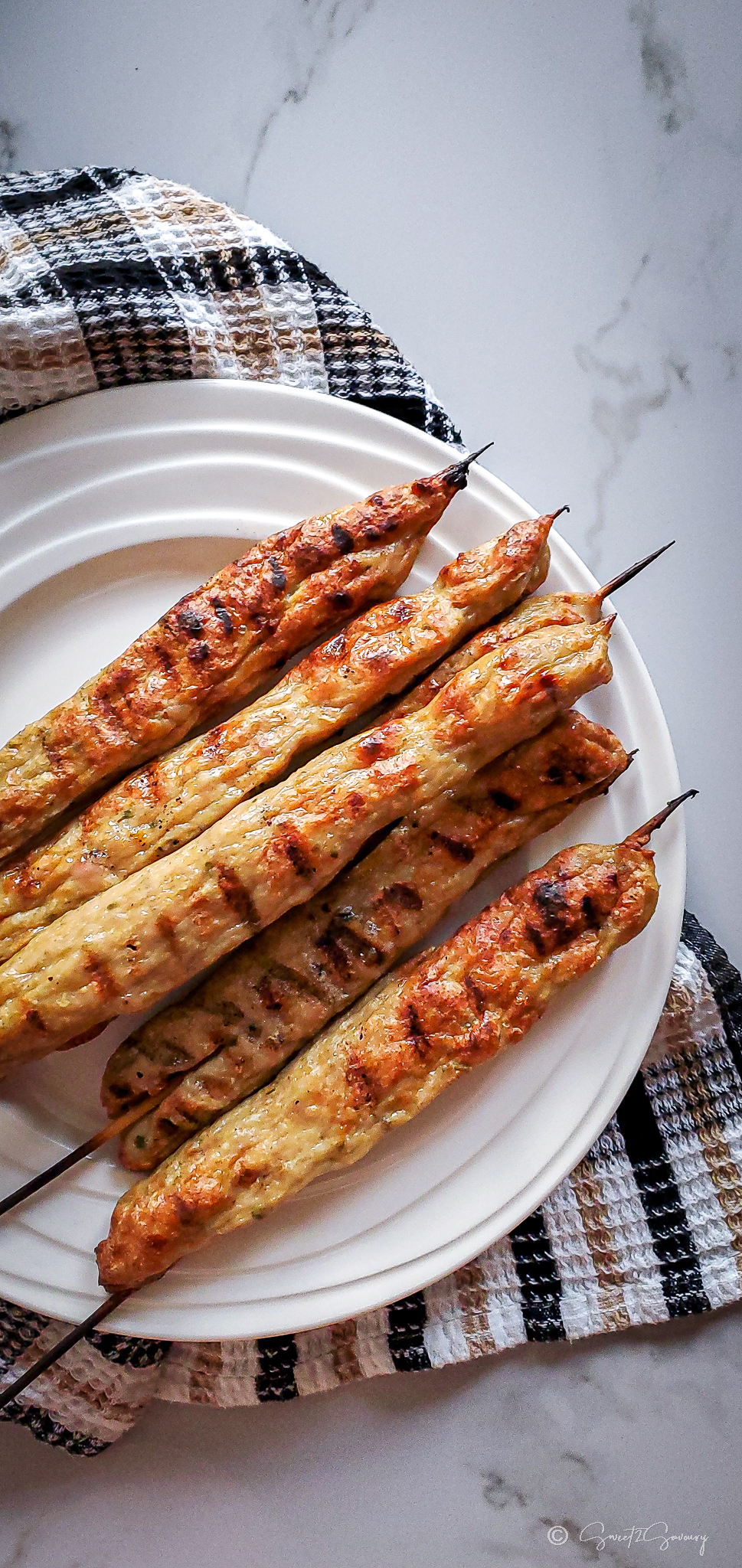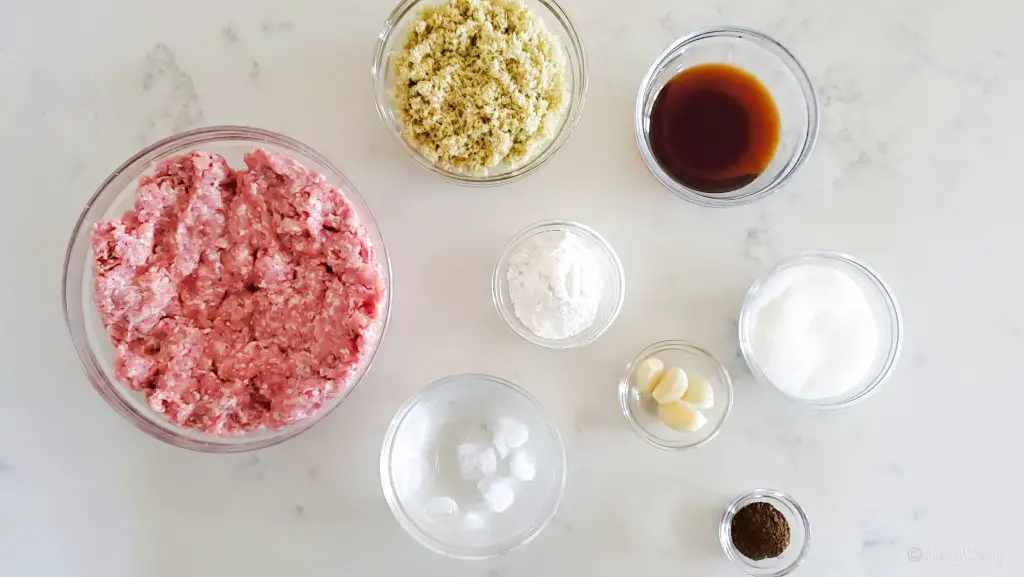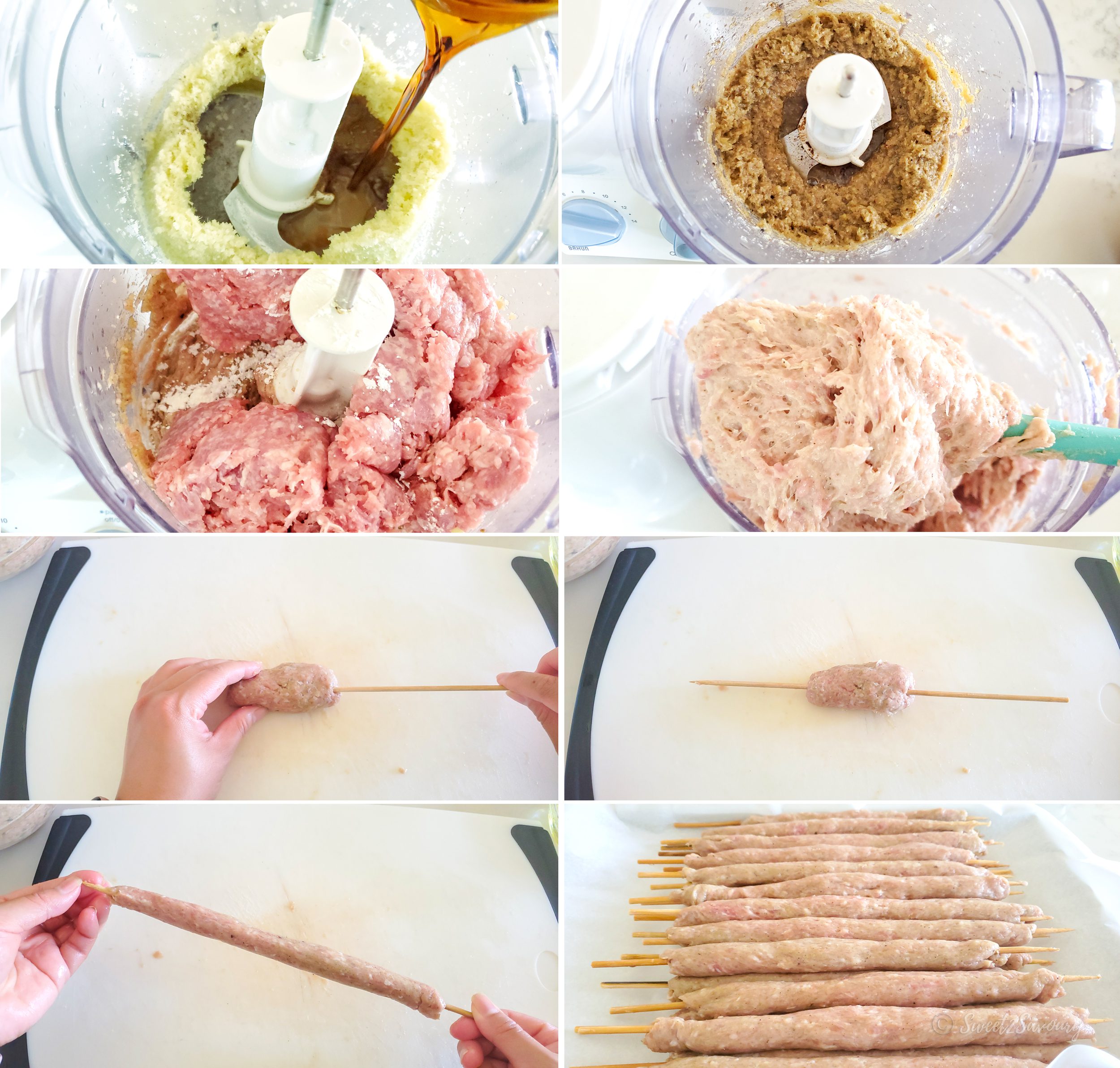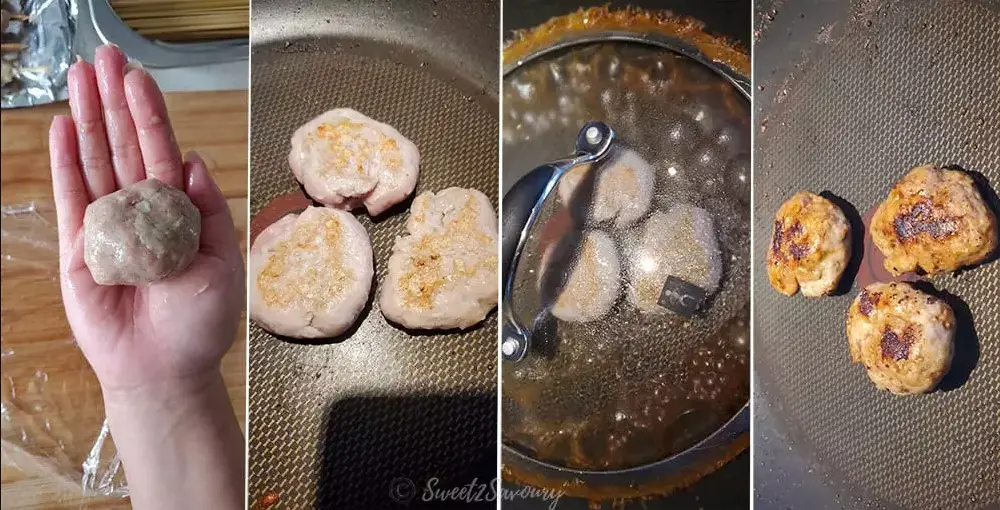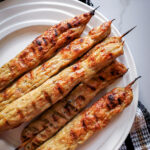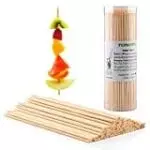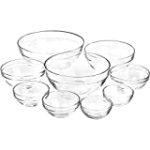Fortunately, depending where you live, there are plenty of asian grocery stores that carry all of the ingredients needed for a vietnamese recipe. So, don’t be afraid to try this! I break down each step for you to follow and explain what each ingredient’s purpose is. I promise, the end result will be worth it and you’ll be happy you tried it (hopefully inspired to cook it again too!)
*Good To Know*
- What is lemongrass and where can I find it?
Fresh lemongrass looks like a stalk with long grass blades and is also known as barbed wire grass (because of its harmless ‘razor’ like grass blades). Its scent can be described as a pleasant citrus scent, similar to a mix of ginger, mint and lemon. It’s a common herb used in vietnamese or thai dishes but its fragrance can also be found in scented oils, soaps, lotions, candles and so many more. Lemongrass can be purchased fresh or frozen (minced & whole).
For our pork skewer recipe, frozen minced lemongrass is preferred for the purpose of convenience. You can mince fresh lemongrass if that’s what you prefer (or if you can’t find it in the frozen aisle). Learn how to mince fresh lemongrass to freeze in my how-to section here. - What is Fish Sauce? How to choose a good one?
These days, fish sauce seems to be a well-known condiment and is a go-to staple in asian cuisine. It’s made with anchovies (or squid) that have been covered in salt/ water and fermented in wooden barrels for a couple of years. By doing so, the umami taste you get in the fish sauce is what brings out a different note of salty / earthy flavour in a dish and is uniquely delicious! Some may not be fond of its distinct ‘fishy’ or pungy smell, but once cooked, the flavour is more prominent than the smell.
It may be tempting to buy fish sauce that is cheap in price, however, I recommend buying fish sauce at a mid to premium price for better quality. Choose fish sauce bottled in glass (not plastic) and one that has been imported from Vietnam ( if it says “Phu Quoc” or made in “Phu Quoc” even better since that’s a famous area where a lot of the fish sauce is made). Look for a light amber colour and avoid the dark brown coloured fish sauce. - Why use ice water for the recipe?
I’ve made this dish numerous times and adjusted it based on testing different methods. Ice water helps keep the meat cold (and juicy for grilling). The meat tends to warm a little while it’s being minced in the food processor. - Can I freeze the meat sticks?
Yes you can. Freezing or refrigerating the meat for a minimum of 30 minutes or longer helps the meat develop more flavour and allows the meat to retain juicy texture by the time it’s grilled because we’ve stopped the fat within the meat from melting. - Can I use lean ground pork?
I highly recommend using medium ground pork (where the fat content is higher) because this is what minimizes the meat sticks from turning tough and dry. Understandably, lean ground pork is more commonly found at the grocery store. If you can’t find medium ground pork, add 2 tablespoons of vegetable oil to the marinade. - Can I skip adding sugar?
Savoury vietnamese recipes call for white, cane or palm sugar a lot of the times (typically southern vietnamese dishes). My recommendation is to add sugar for a balanced flavour profile however, if you feel strongly about not adding sugar, I recommend reducing the fish sauce by 1 to 2 Tablespoons. Aside from flavour, the sugar is what also gives this meat recipe it’s browning colour once grilled. - Why the cornstarch?
Because of the liquids I’ve added to the ground pork, I needed a binding agent to keep the meat together. Instead of using eggs, I used cornstarch since it has the same effects of binding the meat without the additional liquid (and flavour change) you would get with eggs. - Can I pan fry or bake the meat instead?
Pan frying the meat as small meat patties works too. Shape them into small discs, cook on high heat with a little water in the pan and cover with a lid. Once the water has almost evaporated, remove lid and continue to pan fry (with flippings in between) until the meat is fully cooked and browned.
If you choose to bake, you can shape it into discs or meat sticks and bake at 350°F for 20 minutes or until the meat is cooked. To give it some colour, broil on high for 3 minutes.
Let me preface….traditional vietnamese grilled pork (Nem Nướng) does not have lemongrass in it. This is my version of Nem Nướng since I am a huge fan of lemongrass and wanted to incorporate it. Traditional Nem Nướng is made slightly different with garlic, green onions and a hint of food color ( recipe post for that coming to you at a later time).
What you need to prepare and grill pork skewers
If you have eaten at a vietnamese restaurant before, this type of meat (Nem Nướng) is typically served as an appetizer (pink meat on a sugar cane stick) or in a vermicelli meal combo. It’s sweet/savoury/fatty in flavour and very delicious!
My homemade, lemongrass version entails the following ingredients:
• ground pork • cornstarch
• lemongrass • black pepper
• fish sauce • ice water
• sugar
By using a food processor, everything is mixed in one appliance and all you need to do is shape the meat onto the skewers. Quick. Easy. Tasty!
How to pan fry or bake pork patties
If you don’t have a barbecue or grill, you can still cook this meat on the stovetop with a nonstick pan and a lid. Shape your meat into small discs (so they cook faster). On high heat sear the patties on both sides to seal the meat, add about 1/4 cup of water and close lid. Bring water to a boil and occasionally flip the meat while it’s cooking in the water. When water has mostly evaporated, remove lid and continue to cook the patties until all of the water has evaporated and you’re left with some grease from the meat that will help finish browning it.
To bake, shape the meat into patties or sticks and bake at 350°F (176.7°C) for 20 to 25 minutes (flip half way). Broil on high for 3 minutes to give it a golden brown colour.
Looking for more skewer ideas to grill? Try my Teriyaki Sesame Beef skewers recipe or my Marinated Veggie Skewers and let me know what you think!
Are you looking for more recipes like this one? I have gathered 12 of my best skewer recipes along with kitchen techniques, ingredient insight, alternate cooking method and more in an eBook. Learn more about it here.
Grilled Lemongrass Pork Skewers (Nem Nướng Sả)
Ingredients
Tools
- 24 skewers wooden or bamboo, soaked in water for 1 hour
Lemongrass Pork
- 3 tablespoons garlic (4 cloves), peeled
- 5 tablespoons white sugar
- 1½ cups minced lemongrass, frozen or fresh
- 1 teaspoon ground black pepper
- ⅓ cup premium fish sauce
- ½ cup ice water
- 2½ pounds medium ground pork, (if using lean ground pork, add 2 tablespoons vegetable oil)
- 3 tablespoons corn starch
Oil For Greasing
- ¼ cup vegetable oil
INSTRUCTIONS
- Soak wooden skewers in water for 1 hour prior to grilling (to help prevent sticks from burning too quickly)
- Add to the bowl of a food processor garlic, sugar and lemongrass. Process on high speed for 1 minute, then add ground black pepper and fish sauce and process on high for another minute.
- Add half of the ground pork to the minced lemongrass in the food processor and process on high until everything is combined. Pour in 1/2 cup cold water (without the ice) and continue to mince on high speed for 1 minute. Lastly, add all of the cornstarch with remaining ground pork and mince on high speed until well combined. Scrape bowl down in between mincing. Refrigerate the meat in a large bowl covered with plastic wrap for 1 hour.
- When ready to skewer meat, line a baking tray with parchment or wax paper. Grease with cooking oil; a 1/4 measuring cup, your cutting board (or work surface) and your hands (this is to prevent the meat from sticking while you work).
- Scoop meat with your 1/4 measuring cup and shape meat into a ball with your hands. Then place the meatball onto your cutting board and roll it into a short, 2-inch log. Use a wooden skewer and pierce it through the center of the log, lengthwise until it is centred on the stick. Roll meat back and forth until you have covered 90% of your skewer stick with the meat. Leave a 2-inch gap at the bottom for grip. Pinch both ends closed if needed to seal meat onto your stick. Place the skewer on your tray. Repeat this step until all of the skewers are covered with meat. Continue to grease your measuring cup, hands and work surface in between to make sure none of the meat sticks to your work surface.
- Refrigerate skewers (covered with plastic wrap) for 30 minutes (up to 1 hour) or until ready to grill to prevent the fat from melting and to keep your meat firm. Grill meat sticks on medium-low heat (with lid on) on your outdoor grill for 5 to 10 minutes (flipping it often) or until fully cooked and lightly browned. Reduce heat to low if the meat burns too quickly.
Equipment
Tips
For our pork skewer recipe, frozen minced lemongrass is preferred for the purpose of convenience. You can mince fresh lemongrass if that’s what you prefer (or if you can’t find it in the frozen aisle). To mince, cut off 0.5 cm or the hard stem part of the lower bulb and then peel off the tough outer leaves. What you should be left with is the main yellow stalk that is soft. Thinly slice it with a sharp knife and process it in a food processor until finely minced (since it’s quite stringy and fibrous, make sure to mince this well). What is Fish Sauce? How to choose a good one? These days, fish sauce seems to be a more well-known condiment and is a go-to staple in asian cuisine. It’s made with anchovies (or squid) that have been covered in salt/ water and fermented in wooden barrels for a couple of years. By doing so, the umami taste you get in the fish sauce is what brings out a different note of salty / earthy flavour in a dish and is uniquely delicious! Some may not be fond of its distinct ‘fishy’ or pungy smell, but once cooked, the flavour is more prominent than the smell. It may be tempting to buy fish sauce that is cheap in price, however, I recommend buying fish sauce at a mid to premium price for better quality. Choose fish sauce bottled in glass (not plastic) and one that has been imported from Vietnam ( if it says “Phu Quoc” or made in “Phu Quoc” even better since that’s a famous area where a lot of the fish sauce is made). Look for a light amber colour and avoid the dark brown coloured fish sauce. Why use ice water for the recipe? I’ve made this dish numerous times and adjusted it based on testing different methods. Ice water helps keep the meat cold (and juicy for grilling). The meat tends to warm a little while it’s being minced in the food processor. Can I freeze the meat sticks? Yes you can. Freezing or refrigerating the meat for a minimum of 30 minutes or longer helps the meat develop more flavour and allows the meat to retain juicy texture by the time it’s grilled because we’ve stopped the fat within the meat from melting. Can I use lean ground pork? I highly recommend using medium ground pork (where the fat content is higher) because this is what minimizes the meat sticks from turning tough and dry. Understandably, lean ground pork is more commonly found at the grocery store. If you can’t find medium ground pork, add 2 tablespoons of vegetable oil to the marinade. Can I skip adding sugar? Savoury vietnamese recipes call for white, cane or palm sugar a lot of the times (typically southern vietnamese dishes). My recommendation is to add sugar for a balanced flavour profile however, if you feel strongly about not adding sugar, I recommend reducing the fish sauce by 1 to 2 Tablespoons. Aside from flavour, the sugar is what also gives this meat recipe it’s browning colour once grilled. Why the cornstarch? Because of the liquids I’ve added to the ground pork, I needed a binding agent to keep the meat together. Instead of using eggs, I used cornstarch since it has the same effects of binding the meat without the additional liquid (and flavour change) you would get with eggs. Can I pan fry or bake the meat instead? Pan frying the meat as small meat patties works too. Shape them into small discs, cook on high heat with a little water in the pan and cover with a lid. Once the water has almost evaporated, remove lid and continue to pan fry (with flippings in between) until the meat is fully cooked and browned.
If you choose to bake, you can shape it into discs or meat sticks and bake at 350°F for 20 minutes or until the meat is cooked. To give it some colour, broil on high for 3 minutes.

